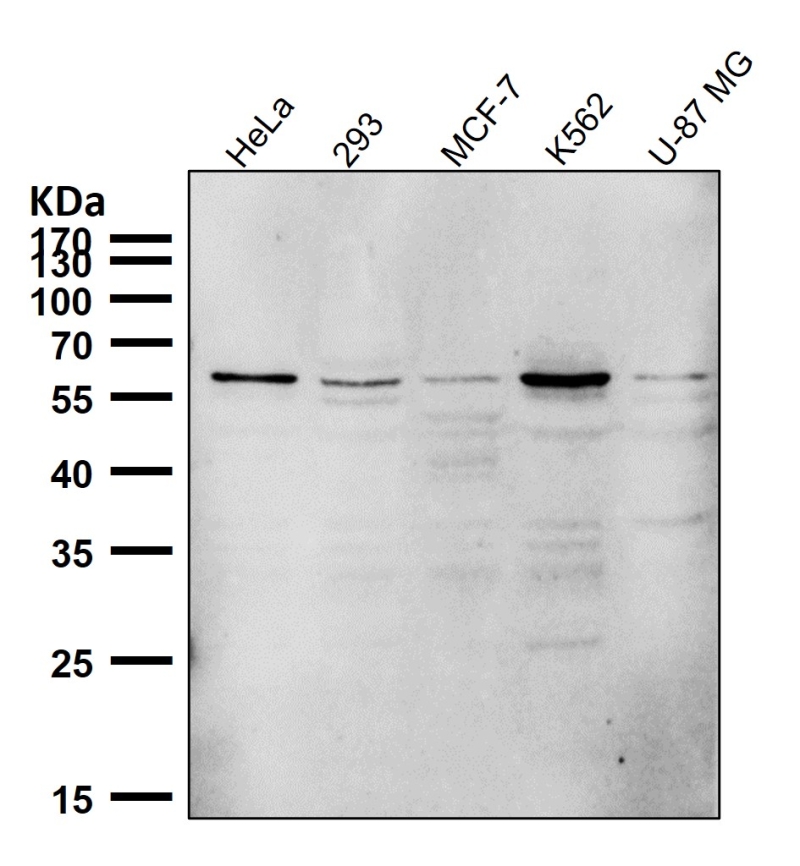

| WB | 咨询技术 | Human,Mouse,Rat |
| IF | 咨询技术 | Human,Mouse,Rat |
| IHC | 咨询技术 | Human,Mouse,Rat |
| ICC | 技术咨询 | Human,Mouse,Rat |
| FCM | 咨询技术 | Human,Mouse,Rat |
| Elisa | 咨询技术 | Human,Mouse,Rat |
| Aliases | MIBP; nPTB; nPTB5; nPTB6; nPTB7; nPTB8; PTB; PTBLP; Ptbp2;;PTBP2 |
| WB Predicted band size | Calculated MW: 57 kDa ; Observed MW: 55 kDa |
| Host/Isotype | Rabbit IgG |
| Antibody Type | Primary antibody |
| Storage | Store at 4°C short term. Aliquot and store at -20°C long term. Avoid freeze/thaw cycles. |
| Species Reactivity | Human,Mouse,Rat |
| Immunogen | A synthesized peptide derived from human PTBP2 |
| Formulation | Purified antibody in PBS with 0.05% sodium azide,0.05% BSA and 50% glycerol. |
+ +
以下是关于PTBP2抗体的3篇参考文献示例,包含文献名称、作者及摘要概括:
---
1. **文献名称**: *PTBP2 controls neural alternative splicing and synaptic plasticity*
**作者**: Licatalosi, D.D., et al.
**摘要**: 本研究利用PTBP2特异性抗体,通过免疫沉淀和RNA测序揭示了PTBP2在小鼠大脑中调控突触相关基因的选择性剪接,影响神经元可塑性和学习记忆功能。
2. **文献名称**: *PTBP2 is required for embryonic development and regulates pluripotency in stem cells*
**作者**: Shibayama, M., et al.
**摘要**: 通过PTBP2抗体进行Western blot和免疫荧光实验,发现PTBP2在小鼠胚胎发育中不可或缺,并调控干细胞的自我更新与分化平衡。
3. **文献名称**: *PTBP2 modulates oncogenic splicing in colorectal cancer*
**作者**: Wang, Z., et al.
**摘要**: 使用PTBP2抗体对结直肠癌组织进行免疫组化分析,发现PTBP2通过异常剪接促进肿瘤进展,其高表达与患者不良预后相关。
---
以上文献摘要均提及PTBP2抗体的实验应用(如免疫沉淀、Western blot等),并聚焦于PTBP2在神经发育、干细胞调控及癌症中的作用。如需具体文献来源,建议通过PubMed或期刊数据库检索标题及作者进一步查阅。
**Background of PTBP2 Antibody**
PTBP2 (Polypyrimidine Tract-Binding Protein 2), also known as nPTB, is an RNA-binding protein involved in post-transcriptional gene regulation, including alternative splicing, mRNA stability, and localization. It belongs to the PTBP family, sharing structural homology with PTBP1 but exhibiting distinct expression patterns and functions. PTBP2 is highly expressed in the nervous system, particularly during neuronal differentiation and synaptic maturation, where it regulates splicing events critical for neurodevelopment and plasticity.
PTBP2 antibodies are essential tools for studying its role in neuronal development, cellular differentiation, and disease. These antibodies enable the detection and localization of PTBP2 in tissues or cultured cells via techniques like Western blotting, immunohistochemistry, and immunofluorescence. Researchers also use PTBP2-specific antibodies to investigate its functional interplay with other RNA-binding proteins or its dysregulation in neurological disorders, cancers, and other conditions linked to aberrant RNA processing.
The development of PTBP2 antibodies often involves immunizing hosts with purified protein fragments or synthetic peptides corresponding to unique regions of PTBP2. ensuring specificity over PTBP1. Validation includes testing against recombinant proteins and knockout cell lines. As PTBP2's dynamic expression and isoform diversity influence its activity, high-quality antibodies are critical for dissecting its complex roles in health and disease.
×